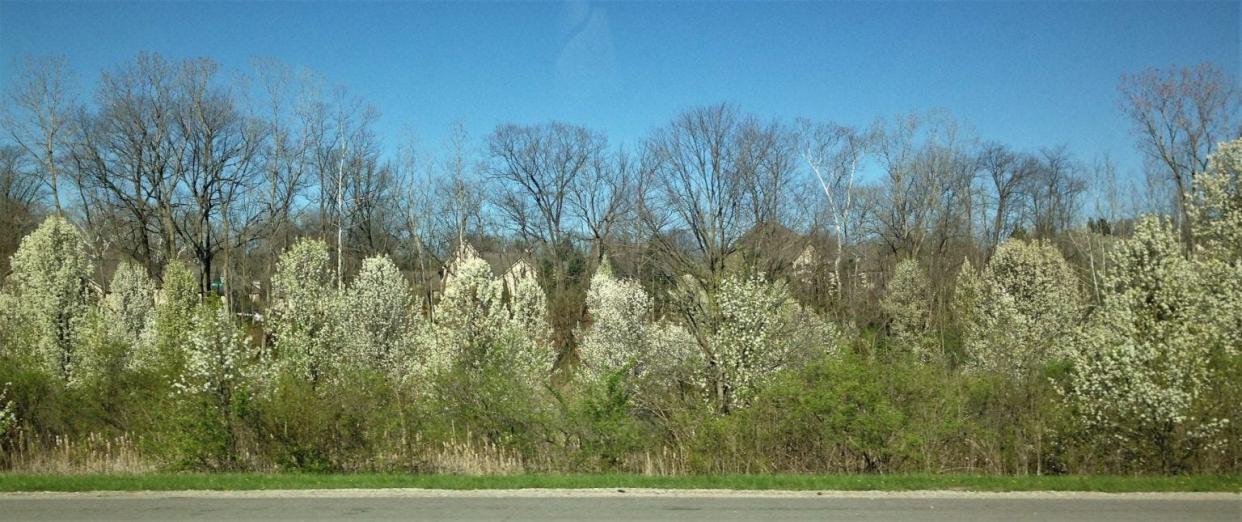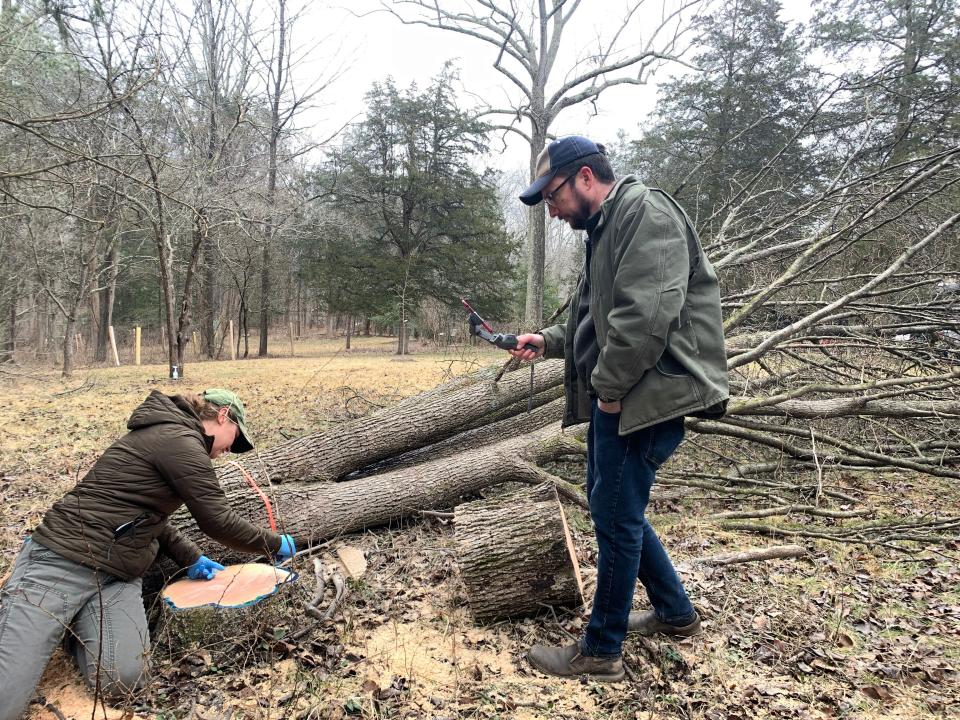Pretty? Smelly? Those white-flowered Callery pear trees are crowding out native species

As blossoms on trees and flowers unfold in the next few weeks, odorous, white-flowered trees will become visible in the edges of woods and perfume right-of-ways along Bloomington streets — and people in Monroe County want to eradicate many of those trees.
Ellen Jacquart and other members of MC-IRIS (Monroe County Identify and Reduce Invasive Species) have begun spreading the word — online, on social media and talking with people in neighborhoods — about how these Callery pear trees are proliferating across the Hoosier landscape, displacing native trees and plants. On the edges of many wooded areas, they are crowding out the flowering dogwoods and redbuds in southern Indiana's spring landscape.
What's wrong with Callery pear?
From the 1960s through the '90s, ornamental pear trees were a favorite for landscaping across the Midwest. As a group they are called Callery pear trees, but they are often better known by their variety names: Bradford, Cleveland Select, Red Spire, Valiant Princess, Autumn Blaze, Aristocrat, Chanticlear, Trinity, New Bradford, Metropolitan, Cambridge, Grant St. Yellow and more. All are considered invasive.

"Everyone loved Callery pear," Jacquart, president of MC-IRIS, explained.
However, birds eat the trees' fruit, spreading seeds across the landscape. The trees, native to China, are crowding out native trees not only in urban landscapes but also Hoosier forests.
In an effort to reduce those numbers in Monroe County, MC-IRIS will concentrate its efforts on the invasive Callery pear during 2022, in the group's Reduce One Invasive Species Challenge. In past years, MC-IRIS named Asian bush honeysuckle and purple wintercreeper as the invasive plants to eradicate.
While the honeysuckle and wintercreeper are on Indiana's list of terrestrial invasive plants that cannot be sold at nurseries and other stores, Callery pear is not on the list.
But that hasn't stopped people, organizations and even cities from removing pear trees.

Removing invasive Callery pear trees
Sycamore Land Trust staff and volunteers removed pear trees — three at its Cedar Crest preserve and about a dozen in the Ghurye Arboretum in the Marlin Hills neighborhood during a recent work days.
The land trust based in Bloomington has been working to eradicate as many Callery pear trees as possible from its nature preserves, most of which have the invasive pear trees in wooded areas.
"It's not at a catastrophe level," Mary Welz, education director for the land trust, told The Herald-Times. "But we have to try and get it in control."
Welz helped with the removal at Cedar Crest, where one of the trees was about 50 years old. It was large for a Callery pear tree, and Welz applied a glyphosate-based herbicide on the outer and inner layer of the stump's bark to ensure the roots would not sprout new growth.

"Any time we take down one of those trees, we want to be planting native trees in its place," Welz said, adding that Sycamore Land Trust plants thousands of trees each year on its preserves.
Welz encouraged people who see Callery pear trees growing along highways and roadways to contact the highway department responsible for the road to report the trees.
"It starts in a right-of-way and eventually it will get into our forests," she explained.
Callery pear smell and other issues
The ornamental pear trees have other issues as well — the fruits smell like rotting fish, Welz said. And the trees have a weak structure, making them likely to split and splinter as they age, especially in windy weather.
To make sure a tree with white spring flowers is a Callery pear and not a native species such as a dogwood, go to mc-iris.org for identification tips.
Replacing Callery pear with native species
The city of Bloomington no longer plants Callery pear trees, although there are about 1,290 pear trees on city property, according to Erin Hatch, Bloomington's urban forester. That's about 10% of the trees listed in city's tree inventory.
"Right now we don't have any funds set aside for removal and replacement for Callery pear," Hatch said.
She said removing the pear trees will be a priority but won't happen all at once because it would be a "big net loss" of trees throughout the city. This year, the city is setting aside money to remove pear trees along the B-Line Trail.
Many of the pear trees are in the city's right-of-way — along streets and at the edges of lawns — in residential neighborhoods. If residents want to remove a pear tree from the right-of-way portion of their yard, Hatch said they need to fill out a permit and receive approval first.
Some people already have requested this, Hatch said. For many of those sites, a native tree was planted in that space, helping maintain the city's existing tree canopy.

But before a stump is removed or a new tree is planted, the site needs to be examined to ensure there are no problems with utilities underground or nearby. Hatch said residents need the city's approval before planting any trees in the right-of-way and encouraged them to call 811 to have the location of pipes and wires marked.
To help with Bloomington's efforts to reduce the number of Callery pear trees, MC-IRIS is going to donate some native trees that can be planted in the city right-of-way when a pear tree is removed, Jacquart said. The money for the native trees comes from the proceeds from the MC-IRIS native plant sale. Preference will be given to areas of the city where there are fewer trees in general.
"We want to make sure that those places in the city that need more trees get them," she said.
Contact Carol Kugler at ckugler@heraldt.com, 812-331-4359 or @ckugler on Twitter.
This article originally appeared on The Herald-Times: Callery pear trees invasive in the Midwest, invading Hoosier forests

